4 TIPS TO OPTIMIZE QUALITY AND REDUCE CYCLE TIME IN GEAR TOOTH PROFILE GRINDING
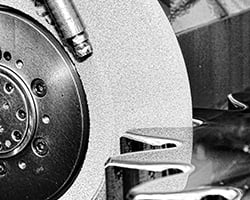
4 Tips To Optimize Quality and Reduce Cycle Time in Gear Tooth Profile Grinding
Published in the February 2024 issue of Gear Technology Magazine
Gear tooth profile grinding, also known as form grinding, is a finishing method used in gear manufacturing. It involves the use of vitrified bonded grinding wheels to modify or correct the profile of gear teeth, often after heat treatment. The grinding wheel runs between two opposing teeth, grinding both surfaces at the same time.
Compared to gear cutting, this process is known to provide a more accurate tooth finish and offers more versatility because of its ability to make a specific, unique profile or to make profile corrections by dressing the wheel with the required corrections or modifications. In most applications, a type 1 or type 4 wheel is used. The machine and gear geometry will determine the size of the wheel.
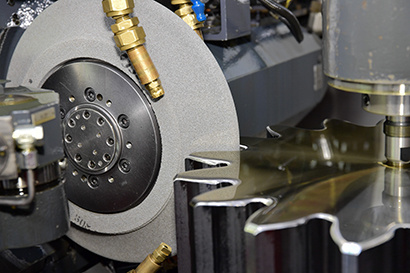
Profile grinding offers versatility and can be used on gears with clearance issues that do not allow for other grinding processes.
Because of the quality requirements involved, profile grinding can be a very labor- and cost-intensive process — making it a critical part of overall gear production for a manufacturer. Therefore, it’s important to choose the right wheel and to follow best practices that will help reduce cycle time, reduce burn risk and optimize quality in these operations.
Profile grinding basics
Gear tooth profile grinding is a discontinuous process that grinds both the right and left gear tooth flanks at the same time, gap by gap. The grinding wheel is dressed in with the exact dimensions of the gear being ground. Most machines use a rotary diamond dresser mounted in, either behind the grinding wheel, on top of the wheel or below it. During the process, the dresser and grinding wheel (or a combination of both) move in multiple axis to achieve the desired gear tooth profile. Compared to continuous generating gear grinding, where the profile is produced by the generating movement, in this process the profile is generated by the profile form that is dressed in the grinding wheel. This helps provide greater profile accuracy.Most of the time, gear grinding is the last step in the manufacturing process. After grinding, the gear is typically prepared for assembly. The machines used in this process vary by manufacturer and size. Some machines are capable of grinding gears up to 6096 mm in diameter inside an enclosure. Other machines are built for larger production batches and can be equipped with automated loading and unloading capabilities, although most material handling in and out of the grinder is typically done manually with hoists.
Challenges of profile grinding
There are several challenges that can affect the cycle time and quality produced in profile grinding. These include:
- Grinding burns: Burning is usually the most crucial quality element in profile grinding. When not managed correctly, burning can cause scrap and increased cycle times.
- Form holding: The grinding wheel’s ability to hold form is the next most-important quality element, and it has a direct impact on cycle time and gear geometry.
- Operator skill level: It’s crucial that the operator has gear knowledge and machine training in profile grinding. Finding, training and retaining these operators can be challenging.
- Grinding wheel life: It’s important to choose a wheel that can achieve all the quality requirements while also providing the most tool life. Using the correct grinding strategy can help extend wheel life. This makes application training for profile grinding operators especially key to ensure they are using proper grinding strategies.
- Incorrect parameters: The overall grinding strategy must be determined first, then machine parameters can be programmed or adjusted. Using incorrect programming parameters in the profile grinding process can result in increased cycle time, poor gear quality, burning and increased scrap in gear production. Consulting with an application engineer, such as from an abrasives manufacturer like Weiler Abrasives, can improve results.
- Production bottlenecks: The profile grinding process can be a source of bottlenecks. For example, very large gears or a grind-from-solid operation may have a two-to-12-hour cycle time. A strategic change to the grinding wheel itself or perhaps a parameter adjustment can potentially cut that time in half or more.
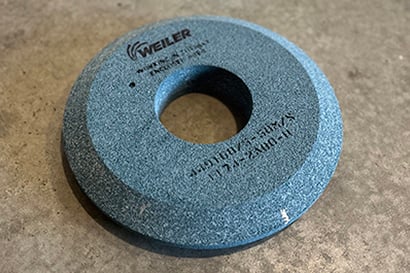
A high performance profile grinding wheel from Weiler Abrasives, showing the high porosity of the wheel. These high performance wheels offer better form holding and longer wheel life.
Abrasive product options
Many formulations are available when choosing a grinding wheel. Different wheels will have different results depending on gear hardness, size, and finishing method. Other factors to consider include wheel size (width and diameter) and rated speed. Different types of wheels can provide varied cutting properties, durability, and product life.
 An open porosity, vitrified bonded wheel uses either aluminum oxide grains or high-performance ceramic grains. For profile grinding, it’s preferred to use a wheel with induced porosity, or very large pores, to reduce the risk of damaging or scrapping the part. This image shows an open porosity wheel after grinding with no sign of loading.
An open porosity, vitrified bonded wheel uses either aluminum oxide grains or high-performance ceramic grains. For profile grinding, it’s preferred to use a wheel with induced porosity, or very large pores, to reduce the risk of damaging or scrapping the part. This image shows an open porosity wheel after grinding with no sign of loading.
Typically, profile grinding operations select an open porosity, vitrified bonded wheel that uses either aluminum oxide grains or high-performance ceramic grains. This differs from the wheels used in continuous generating gear grinding, which typically uses a normal or non-induced porosity wheel. For profile grinding, it’s preferred to use a wheel with induced porosity or very large pores to reduce the risk of damaging or scrapping the part — which can add considerable cost to the operation — it’s important to use the correct wheel for the job. Even if the operation is not running the wheel at its maximum capacity, choosing the right wheel can help avoid disastrous results. One wrong grinding wheel can potentially cost a company thousands of euros or more if the gear fails after it is installed and in use.
Look for an abrasives manufacturer that can assess your application requirements and produce a wheel for profile grinding that will deliver optimized performance. A quality manufacturer can engineer customized grinding wheels in a variety of grit sizes and abrasive grain types that are adapted for use with a wide range of CNC machines.
4 tips for profile grinding
Optimizing quality and reducing cycle time in profile grinding requires attention to some important best practices. Grinding strategy also plays a pivotal role, so be sure to consider factors such as “how many teeth can we grind before we need to dress?” Keep in mind these four tips for profile grinding:
- Better form holding:
There are two elements in the grinding cycle to consider: grind time and dressing time. The in-cycle dressing time can be between three to eight minutes or more. Therefore, the better you can hold the form, the longer you can cut between dressing cycles and the faster your cycle time will be. This makes application training for profile grinding operators especially key to ensure they use proper grinding strategies. Consult an abrasives manufacturer to formulate a wheel with optimal grain and bond technology to maximize form holding.
- Cooler cutting:
The most crucial quality element in profile grinding is the risk of burning. Burning, or tempering, is when the tooth surface has been exposed to very high temperatures from the grinding process. This can decrease hardness and cause stress to the gear material, resulting in cracking that will lead to gear failure. Most machines have high-volume coolant systems that allow for adequate flooding properties to wash away metal chips created by the grinding wheel and high-pressure nozzles to clean the wheel. Before a grinding wheel can be chosen, these conditions must be met, or the wheel will not perform as designed. A wheel that cuts cooler can provide numerous benefits. As you increase performance and wheel aggression, it’s important to choose a wheel that enables cooler cutting to avoid burning the part and possible wheel failure. A wheel grinds cooler by maximizing the exact timing of the grain releasing from the bond and having the proper grain technology for the job. When a high-performance grinding wheel can cut cooler, it may be possible to cut faster. In addition, having the gear blank roughing process as accurate as possible or of optimal geometry and size before grinding will lower the risk of quality failures and help stabilize the grinding operation.
- Increase wheel life with higher cutting volumes (V’w):
Cutting volume is the measure of how much gear tooth material can be removed before the geometry must be corrected, also known as when form loss occurs. When a machine is set up, the form is dressed into the wheel and the gear is ground — so the form is on the gear. The same form on the wheel is copied onto the gear.
How many times this can be done before the form is out of tolerance or unacceptable is known as the achievable cutting volume, which is a volumetric calculation. Remember, the in-cycle dressing time can be several minutes; therefore, cycle time reduction can be achieved by optimal grinding and dressing strategy. Different grinding wheels have different cutting volumes. Generally, economical grinding wheels have a lower cutting volume, while high-performance wheels have a very high cutting volume. Higher cutting volumes will equate to longer wheel life and lower cycle time. A lower cycle time is achieved by reducing the amount of dress intervals. When the grinding strategy is correct and optimized, you will get the best result from a high-performance wheel.
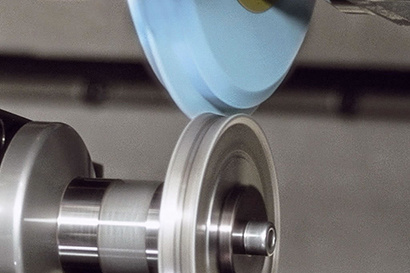
Action of a profile grinding wheel being dressed to demonstrate the method used.
Generally, economical grinding wheels have a lower cutting volume, while high-performance wheels have a very high cutting volume. Higher cutting volumes will equate to longer wheel life and lower cycle time. A lower cycle time is achieved by reducing the amount of dress intervals. When the grinding strategy is correct and optimized, you will get the best result from a high-performance wheel.
- Reduce cycle time with high material removal rates (Q’w):
Improving the material removal rate (MRR) will decrease cycle time. Material removal rate is a metric used to understand how fast workpiece material is removed by the grinding wheel. The higher the value, the higher the rate of removal. A higher MRR can be achieved by either increasing the amount of stock or increasing the wheel feed rate — or a combination of both. The formula for Q’w is:
𝑄′w = (𝑎𝑒 * 𝑣𝑤)/60
where,
𝑎𝑒 = amount of material, units in volume
𝑣𝑤 = feed rate, units in distance / time
Depending on the grinding wheel technology used, a high feed rate may be preferred instead of a low feed rate and high stock removal amount. This is a common factor used in grinding and is usually one of the first questions asked by operators. The Q’w formula shows you can adjust the material removal rate by understanding how to apply the correct grinding wheel technology to optimize stock amount, feed rate or both. It is important to note that gears with a low number of teeth have a variable Q’w along the profile from root to tip. Because the profile angle varies from root to tip on medium- to large-pitch gears, this type of gear will require a different grind strategy to achieve quality and prevent burn. As with other elements of the grind process, Q’w is impacted by the coolant system, gear geometry and other factors. Consider also that as you increase the removal rate in terms of feed rate, it can put added stress on the machine and cause premature machine failures, adding maintenance and downtime.
Improve profile grinding
Quality and efficiency are critical in profile grinding. A gear application engineer can design a grinding strategy for a specific gear before taking the machine offline and set-up begins. Working with an application engineer from a grinding wheel manufacturer will give the operator or tooling engineer valuable data to design the grinding program with optimal grinding rates and cutting volumes for the specific wheel technology being proposed. They can also determine if the grinding wheel technology is correct or if it needs to be redesigned or changed. Manufacturers want to be cost-effective and reduce cycle time in profile grinding, but first and foremost they must maintain extremely high quality, making cycle prediction with programming crucial. The right grinding wheel manufacturer understands these challenges and can work with operators and engineers to formulate a wheel that is the best fit — to help save costs and optimize cycle time without sacrificing quality.

Dennis Brown,
Technical sales manager,
Weiler Abrasives
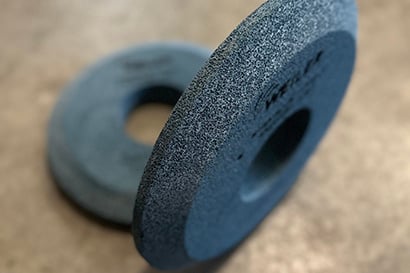
Some profile grinding wheels come pre-formed from the manufacturer, as shown in this example of a high performance profile grinding wheel from Weiler Abrasives.